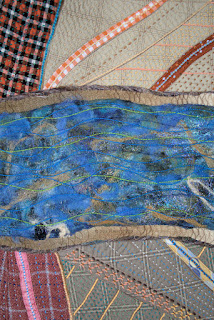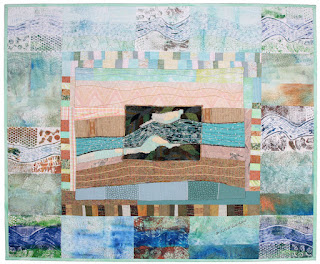 |
| Flash Flood Warning |
The exhibit will feature 4 of my large-scale quilts I've made over time as my response to living near the river. From my statement: "A major source of inspiration for my work, bordering on obsession, is the Susquehanna River. I grew up in a house on a hill overlooking the river and took its presence for granted. When I moved to Lancaster to attend Franklin and Marshall I began to explore the river hills in earnest, hiking the trails and learning about all the best overlooks. My enthusiasm was deepened during the decades I spent living near the Northeast Lancaster County River Trail and exploring it on my bike. I’ve enjoyed learning about the important historical impact of the river on the region. Most of all, I’ve come to appreciate how incredibly beautiful, and everchanging in its aspects, the Susquehanna is. It’s been a privilege and a pleasure to spend time interpreting my impressions using the art quilt medium."
 |
| Flash Flood Warning, detail 1 |
 |
| Flash Flood Warning, detail 2 |
It features a needlefelted and extensively hand embroidered river panel, and wet cyanotype prints of two native Pennsylvania plants, snake root and Solomon's seal.
 |
| Flash Flood Warning, detail 3 |
It measures 59'h x 49'w.
 |
| Flash Flood Warning, detail 4 |
About the Susquehanna: Archaeology of the Lower Susquehanna River reveals that American Indians had utilized its resources for thousands of years. Around 1550 AD, the people we know as the Susquehannock moved from higher up the river to the Lower Susquehanna Valley. The Susquehannock were Iroquoian speakers and shared many similarities with the Iroquois in New York. Learn more here.
I'm now on Bluesky! Pick your platform to find and follow my content, and as always, thanks for reading.
Threads: www.threads.net/@sue_reno_studio
Facebook page: www.facebook.com/suerenostudioInstagram: www.instagram.com/sue_reno_studio/



















